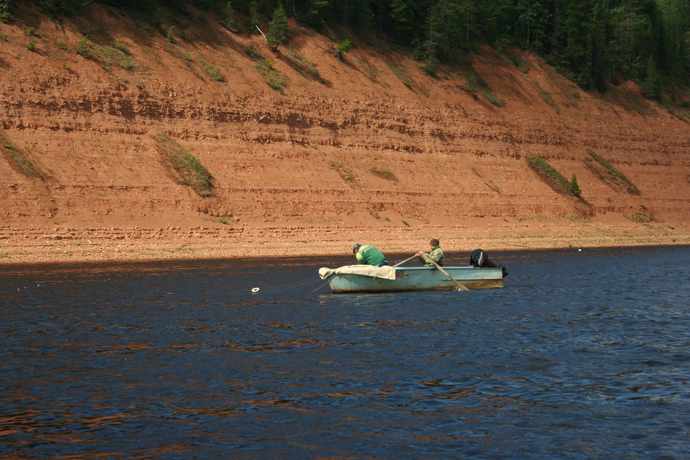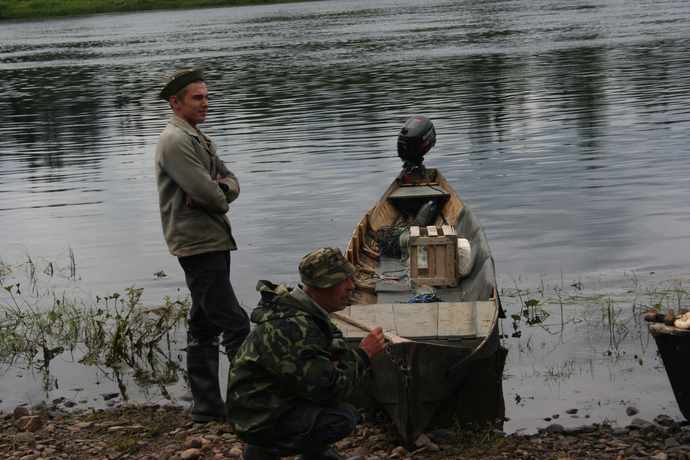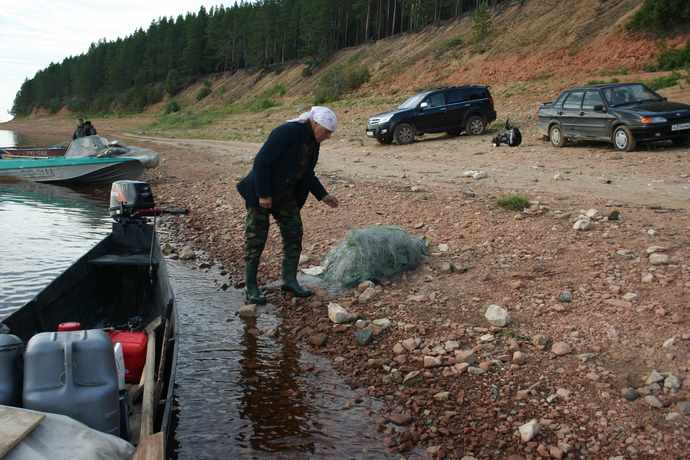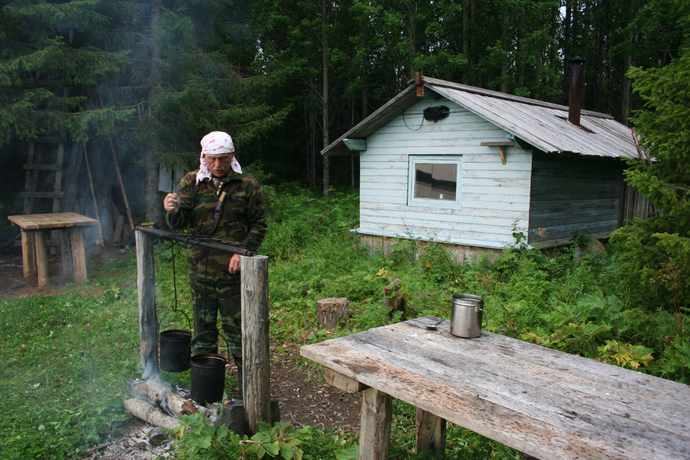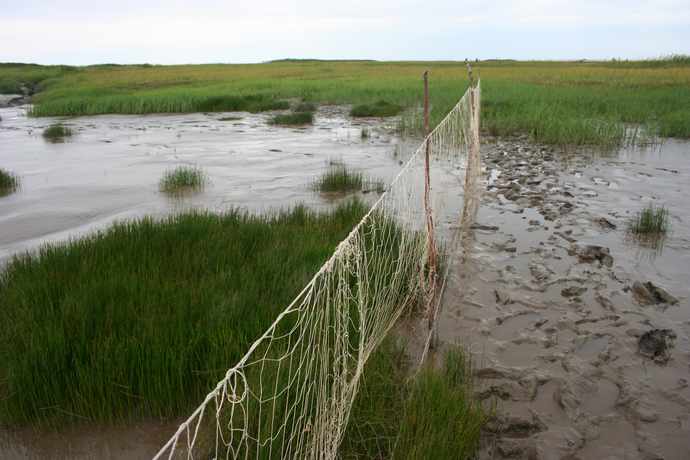Down the river Mezen: illegal salmon fishing is carried out everywhere
An expedition to the lower reaches of the Mezen conducted at the end of July – beginning of August within the frameworks of the “Model river Mezen” project showed that the banning policy prevailing in the Russian legislation in the field of the fish protection and fishing does not work in reality.
An expedition team consisting of two Silver Taiga Foundation employees, as well as specialists of the Federal State Institution “Komirybvod” and a representative of the local residents of the Udora district, walked more than 450 km down the Mezen – from the village Bolshaya Pyssa to the city Mezen and further on – with the entry to the Mezen Bay of the White Sea. A specialist of the Federal State Institution “Sevrybvod” from the city Mezen joined the group already at the end of the trip, before the entry to the bay.
The group had several tasks. The first and the main one was to get familiar with the problems of the lower part of the Mezen, related to the fish resources condition and their management. Besides, it was important to check what had changed compared to the last summer on the areas, which had already been examined – from the Pyssa to the Sula; what was a social and economic situation in the villages alone the Mezen, as well as the significance of the river resources for the livelihoods of the local population.
The main conclusion, which can be done based on the results of the expedition, is that the illegal salmon fishing is carried out everywhere: from the Udora village Bolshaya Pyssa up to the mouth of the Mezen and the Mezen Bay in the Arkhangelsk region.
According to Yury Pautov, Deputy Director of the Silver Taiga Foundation, and a leader of the expedition, the evidence could be found anywhere. There are fences (in Komi they are called “sai”) arranged all along the river. On its straight and deep parts the traces of the drift net passage are visible. The participants of the expedition have seen the process of the salmon fishing by the drift net in full public view during the daytime at least six times.
– It feels like the fishermen in the Arkhangelsk region consider this to be an absolutely ordinary thing, nobody is afraid of anyone, – tells Yury Anatolyevich. – On some areas we saw two-three drift nets at once. It was especially visible upstream of the district center – village Leshukonskoye before the inflow of the Vyshka to the Mezen. Salmon is caught by the local residents who are frequently accompanied by their visiting relatives, friends, and acquaintances. In most cases, according to the fishermen we met, they catch it for their personal consumption and also as gifts and treats. For example, we observed a sharp evidence of such openness of the illegal fishing nearby the village Paluga (Yuromskoye settlement of the Leshukonsky district) on July, 28th. On the high bank of the Mezen people were celebrating the Day of the village and at the same time two boats were fishing by drift nets on the river. It’s not improbable, that the fish was intended for the festive table. Legal bans do not work. It is obvious.
In the Mezen district – downstream of the village Dorogorskoye, as well as in the mouth of the Mezen – downstream of the settlement Kamenka – two fishing plots are allocated where an amateur fishing is organized by the plots leaseholder – “Sevrybvod”. On the first plot salmon fishing by the drift nets is authorized on a 3 km river area. A day-time license costs 450 RUB, one day license – 680 RUB.
– We saw the following picture in the place where the fishing plot started, – tell the participants of the expedition. – 8 cars – “Nivas”, “Volgas”, and foreign brands – are simultaneously standing on the bank. In addition, just as many boats are waiting for their turn to float. The period between two “floats” is 20 minutes, i.e. every 20 minutes a boat with 2 fishermen sails off the bank, they cast 250-400 meter drift net and drift 2-3 kilometers downstream. On return they join the queue again, which continues day and night. It can hardly be called an amateur fishing. It is fishery. Nobody is monitoring the rules observance. It’s difficult to ensure the control and supervision: only three employees are working in the “Sevrybvod” branch providing services for two districts near the Mezen. The same situation exists in the branch of Rybnadzor in the city Mezen.
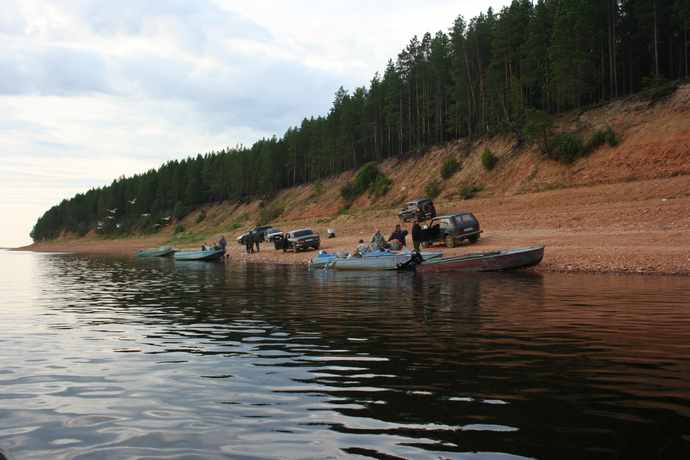
«Amateur fishermen” on the plot of the licensed drift net fishing downstream of the village Dorogorskoye
Down the river there are the areas where earlier commercial salmon fishery was allowed. Now drift net fishing is forbidden here, but it doesn’t bother anyone. In all places suitable for use of such nets the participants of the expedition met the people who were openly fishing-out salmon. Notably, it was possible to buy valuable fish from them right there – 450 rubles per one kilogram. As the fishermen admitted, now the things are better compared to the last year: the water in the river is high and a lot of salmon have entered the waters.
In the very lower reaches of the river Mezen, on its high left bank, fishermen’s huts can be seen every 50-100 meters. They are equipped with electric generators and looking more like summer houses: along the distance of one and a half kilometers we have counted 22 such huts-summer houses, from every of which almost vertical stairs with the heights of 30-40 meters lead to the steep bank. Apparently, people are simultaneously having a rest and doing the commercial fishing here
In the mouth of the Mezen fishing is carried out by other method. There is a high tide wave here (7-8 meters) and the main obstacle for fishing by a drift net is a big amount of rubbish, which is shifted by the wave back and forth. Therefore, the main method of fishing is by means of a set net. All comfortable places in the mouth of the Mezen are fully covered with them: every 50 meters there is a 10-15 meter net. There are hundreds of nets. Near Kamenka, for example, it’s simply impossible to count their amount. In fact, the former villages located in the mouth of the Mezen and Mezen Bay turned into the summer camps for the residents from the city Mezen and settlement Kamenka with fishing as the main activity of their inhabitants.
So, how do the people themselves assess the situation? According to the opinion of the expedition participants, the majority of those with whom they managed to talk consider such state of things to be normal. Of course, they are concerned that the salmon population is decreasing, but they think the following way: if I will not catch it – somebody else will do it, because the salmon fishing will anyhow continue. To make things worse, there is such factor as a disastrous state of the village, because almost in all rural settlements along the Mezen there are such problems as unemployment and low standard of living.
The tsar-fish is also caught in the sea, where the fish husbandries are doing it legally. Besides, the salmon is caught in the Nenets district by the set net placed on the flat sand banks of the Mezen Bay and White Sea. How much do they catch? What do they do with it? Unfortunately, there is no monitoring, no accounting conducted by anybody. There is no state program for conservation of the Mezen salmon population, and an existing practice of the fish resources management is too inefficient.
The data and photo information collected during the expedition, as well as a situation survey prepared by the participants, will be released and will become a subject for discussion of the project Working group with participation of the government institutions representatives.
Translated by Irina Sokolova

